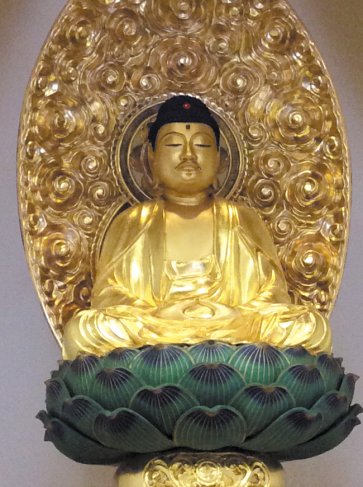A Hand In Understanding Mudras
Mudras are sacred hand gestures prominent in Buddhism and other religions. Just as we use hand gestures to express what’s in our hearts and minds, the various Buddhas display mudras to tell us who they are and give us insight into the powers and teachings they convey. Buddhist followers, too, routinely perform mudras in their worship practices to communicate spiritual truths.
Fingers and hands tell us what’s inside. They also guard us from dangers that threaten us from the outside. This explains, in part, the presence of fierce-looking statues with weapons in their hands placed at the entrance to some Buddhist temples. They brandish weapons to chase away those with ill intentions.
mw-sakashita-042915-sitting
Inside the temples the Buddhas offer different kinds of mudras. There is the mudra of welcoming and blessing (open left hand placed waist high pointing downward with palm facing outward), and a mudra to comfort us and tell us to “fear not” (open right hand placed chest high with palm facing outward and fingers extending upward).
Another common mudra is the meditation mudra. Formed by placing both hands in the lap, one on top of the other with palms turned upward and thumbs touching to form a circle, the meditation mudra is often associated with the Buddha in a seated position. One hand symbolizes the world of enlightenment; the other hand illusion. This mudra thus asserts the triumph of enlightenment over the world of illusion, though the two are intimately connected, as expressed by the touching thumbs. Images of the Buddhas are often depicted with the eyes half-open and half-closed, symbolizing the ability of the Buddhas to watch over the outside world around us as well as to help us see and reflect on the world within us.
Some temples have a standing Buddha on the main altar displaying a mudra similar to the “welcome” and “no fear” mudra described above, but with the thumb and index finger on each hand touching to form a circle that symbolizes the wisdom and compassion of enlightenment in complete harmony. This Buddha leans slightly forward to indicate a readiness to save all beings.
A less common mudra displayed by some of the Buddhas is formed with one finger pointed while the other fingers are closed in a fist. This is a threatening mudra and warns evil to stay away.
Gassho is perhaps the best-known Buddhist mudra. When Buddhists pray, they place their palms together in a symbol of the unity of opposites or complements: oneself and others, wisdom and ignorance, past and present, life and death, the Buddha and all beings. Prayer beads — representing the teachings of the Buddha — often are held around both hands during gassho. Through the embrace of the Buddha’s teachings, followers see that opposites are really one. Gassho expresses the interconnectedness we share with each other and the gratitude that arises from this realization.
The best-known local mudra, however, is the shaka sign. A student in one of my religion classes shared how a Buddhist minister offered an interesting interpretation of our distinctive local gesture. In Japanese, the thumb is called the “parent finger” (oya-yubi) and the pinky is the “child finger” (ko-yubi). When one makes the shaka sign, a universal truth is expressed: The parent looks at the child, but the child looks in a different direction. This is natural. We lovingly watch over our children, but raise them to be independent and find their own paths, so that they can one day succeed when we are no longer around. This is good.
A famous Buddhist story illustrates this: When a rich man asked a Buddhist monk to confer a blessing on his family that would guarantee prosperity, the monk simply offered, “Grandfather dies; father dies; son dies.” In response to the shock and anger of the rich man at being told this, the monk wondered whether the man would prefer his family to experience the events in a different order. For one’s family to experience life in its natural sequence is true happiness. Flashing the shaka sign thus conveys this universal truth and communicates that things are good.
Fingers and hands grasp and cling, or they can reject and push away. They can also embrace, appreciate and let go. They express what’s in our hearts and minds. Indeed, the hand is the visible part of the mind.
Our eyes are such that they only see outwardly. Mudras help one to see inwardly as well. They point to who we are. Mudras help us to see that we are connected to the past, to the future, to each other and to the world around us. They are outward physical signs of inward spiritual states. The next time you see an image of the Buddha, therefore, look closely at the hands. The Buddha may be offering you a hand — or the Buddha may simply be giving you the finger.
misfitspirit808@gmail.com






